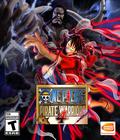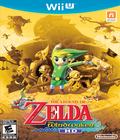There are few Zelda titles that were as controversial as The Legend of Zelda: Wind Waker. A demo at Nintendo's "Space World" had everyone excited for a follow-up to The Ocarina of Time with impressive visuals. The debut of Wind Waker drew extreme reactions from gamers who feared Nintendo was taking the series in the wrong direction. Years later, it's recognized as one of the best games in the franchise, and it may not have been what people wanted, but that makes its accomplishments even more impressive. The Legend of Zelda: The Wind Waker HD is the first time the game has been made available outside of the original GameCube release. Every other Zelda title except for Skyward Sword has been ported or re-released on another system. This may be considered saving the best for last because Wind Waker HD is a fantastic port of a fantastic game.
It's impossible to discuss Wind Waker without mentioning its graphics. The Wind Waker art style was incredibly controversial at its time of release, but despite that, it's remained one of the best-looking games of its generation. The cel-shaded visuals made the game look like a moving cartoon, and while the illusion didn't always hold, it was a delight to see in motion. The HD version revamped the graphics a bit. The lighting engine and character models were upgraded, and there were some small artistic changes that seriously alter the game's appearance. It's still cel-shaded and cartoony but is more realistic, sometimes leaving the characters looking like Claymation models instead of cartoon characters. It still looks amazing, and in several places, it's a drastic improvement over the original game. However, the opening area, Outset Island, has too much bloom compared to other areas, making it look a little worse than the GameCube original.
Wind Waker is utterly charming. Link's younger sister is kidnapped by a giant bird, and Link must join a pirate crew to rescue her. It's all the game needs to set up the adventure. The Zelda games since then have been more serious and dramatic, but Wind Waker has a more natural blend of drama and humor than Skyward Sword or its ilk. Don't let the art style fool you; the game has some surprisingly grim segments, but they're never so grim that they sour the adventure. Link is his usual mute self but demonstrates as much personality through body language and facial expressions as any fully voiced protagonist.
Wind Waker was released as the follow-up to The Ocarina of Time, and it shows. A lot of the gameplay mechanics are nearly identical, and the controls and combat are similar, aside from a "dodge and counter" maneuver. When enemies execute certain attacks, you can press the attack button to parry, roll out of the way and strike them from behind. It's a timed button press but adds extra spice to combat. Beyond that, the mechanics are going to feel very familiar if you've played any of the 3-D Zelda games. Series features like the Z-targeting lock-on system are still present.
Wind Waker had excellent dungeon design for the time, and it's aged quite well. Each area is distinctive and a delight to explore. It avoids feeling too much like you're going through the designated forest area and fire area, even if you're wandering through a giant leafy forest or an active volcano. There's one area about midway through the game that remains one of the most breathtaking sequences that will ever appear in a Zelda title. The puzzles are not overly complex, but they provide a good challenge and a nice break from the combat. As always, the boss battles are a highlight and encourage players to figure out the best way to use the gadgets in their inventory.
One of the neat parts about Wind Waker is that every tool has a purpose. Later games like Twilight Princess had specialized tools that could only be used in certain circumstances, but Wind Waker lets you use all of your gadgets in multiple circumstances. The grappling hook, for example, is used to swing from posts, but you can also equip it in combat to steal items from enemies. The Deku Leaf can be used to glide or to blow gusts at enemies. Each item remains useful throughout the game. A few are more useful than others, but none are as eclipsed as the Command Rod or Spinner. The pacing really makes each gadget feel like an important part of your arsenal.
Of course, the real star is the world. Wind Waker is set in a flooded world, and once you acquire the Wind Waker and your boat, you can explore the entire world map. The map is divided into squares, and each square houses something notable. It may be a side-quest, a dungeon, or a character or location that fleshes out the backstory and world. No Zelda game before or since has put such an emphasis on exploration. Not even the largest version of Hyrule in any previous game felt as large and intimidating as the endless ocean in Wind Waker. It's simultaneously an eerily barren and surprisingly full world. The ocean adds a lot of "filler," but fortunately, the Wii U version of Wind Waker does something to alleviate that.
There are a numerous changes in Wind Waker HD, but none are dramatic. Instead, it's a large number of small but important changes that improve the overall game. Almost every change trends toward making the game faster in some way. The most obvious of these is the Speed Sail, an item you can purchase that halves the time needed to sail across the ocean. There are many minor changes, too. Most of the repetitive animations have been drastically reduced or removed entirely. You no longer have to watch the animations play every time you use the Wind Waker to change the direction of the wind. Minor animations like those for the grappling hook are about twice as fast as they were in the GameCube original. Several bugs and glitches have been fixed, and a variety of minor improvements have been made to the Triforce hunt at the end of the game. There's also a new Hero mode that increases the damage done by enemies and limits the availability of healing items to increase the difficulty of combat. Some modifications allow you to use the Wii U's Game Pad, such as a Miiverse mechanic that lets you send a message in a bottle to other players.
The game still retains a lot of Wind Waker's problems, though. There is a lot of sailing involved, and not everyone is going to enjoy it, even with the addition of the Speed Sail. How much you'll enjoy Wind Waker's overworld depends on how much it appeals to your sense of adventure. If you like the idea of exploring a large, endless ocean with the possibility of something over the next horizon, there's no other Zelda like it. On the other hand, if you preferred the smaller and more densely populated Majora's Mask, the empty space may feel like a waste of time. It's also a somewhat unfinished game. Development problems caused a few dungeons to be cut, so part of the last segment is an extended fetch quest with little "real" content. The HD version somewhat lessens the time spent doing this, but it does little to alleviate the associated pacing problems. It's still the same game, and most of the fixes are patches, not a full-on retrofitting.
The soundtrack is as good as ever and has seen some minor touchups from the original. As ever, there's no voice acting beyond a few minor grunts and yelps, but it doesn't really detract from the experience.
In the end, the biggest problem with The Legend of Zelda: The Wind Waker HD is that it feels like a relatively poor value compared to other HD collections. Most modern HD collections come with multiple games and usually retail for $40. Wind Waker HD contains a flurry of new features, but it's difficult to argue those additional features justify a single game with a price tag that's only $10 less than a new title. Had it been a full-fledged remake or contained more new content, it would be easier to swallow. Wind Waker HD is one of the best HD ports on the market. If you're a fan of Zelda and the $50 price tag doesn't scare you, there's no better version of the game to play.
Score: 8.5/10
More articles about The Legend of Zelda: The Wind Waker HD










 Link sails the high seas and searches for clues to his sister's disappearance. He uses the Wind Waker to compose songs that control wind patterns and summon cyclones. Connect the Game Boy Advance, and players can summon the mapmaker Tingle to uncover secrets to help Link in his voyage.
Link sails the high seas and searches for clues to his sister's disappearance. He uses the Wind Waker to compose songs that control wind patterns and summon cyclones. Connect the Game Boy Advance, and players can summon the mapmaker Tingle to uncover secrets to help Link in his voyage.








































